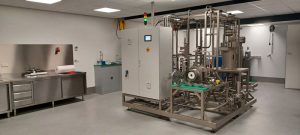In the search for textile processing technologies with low water- and carbon footprints, several novel, sustainable coloration technologies have been developed in the last decade, for both printing and dyeing operations. This can indeed lead to a significant sustainability improvement but the pre- and post-treatments have been largely left out of considerations until now, despite the fact that these have similar water consumptions and carbon footprints.
Scouring of fabrics of polyester and its blends with spandex in conventional jet machines, for instance, uses up to 18,000 liters of water per ton fabric for scouring and subsequent neutralization and generates 1,150 kilograms (kg) CO2 equivalents per ton fabric.
An alternative is solvent scouring, which is on the market but suffers from the inherent disadvantage that organic solvents have a bad reputation for being toxic and flammable. Potential of exposure of workers and the presence of traces of solvent in the end product has prevented this waterless, low-carbon footprint technology from becoming mainstream.
One solution
The Netherlands-based Dye-FF B.V. has developed a solution for waterless, low-carbon footprint scouring, using compressed carbon dioxide (CO2) as non-toxic solvent. Polyester and polyester-spandex fabric is rolled on a beam and perfused by the CO2, which dissolves and takes away all knitting and spinning oil from the fibers.
Gentle Process
The fact that the fabric is not moving in the machine means that even the most sensitive fabrics can be treated with this process. What is more, there will be no microfibers released from the fabric. Downstream of the scouring vessel, the oil is obtained from the machine pure and clean, offering the possibility of circularity by oil reuse.
The pressure and temperature inside the scouring vessel are 60 bar and 20°C, so no shrinking or fiber damage is caused. In addition, if a dope-dyed fabric is scoured, no dye extraction will take place. Relaxation and heat setting has to be done as usual in a tenter after the scouring if the fabric is to be dyed or printed.
Because of the low temperature of 20°C, the energy consumption using this method is low. On top of this, the tenter does not need to dry the fabric and thus extra energy is saved. The total carbon footprint of the process is only 540 kg of CO2 equivalents per ton of fabric — 50-percent lower than the typical 1,150 kg CO2 eq/ton that is characteristic for scouring synthetic fabrics in a jet machine.
Dye-FF has developed this experimental process on a 1-kg scale using an R&D machine designed built by its business partner Ozephius Stainless B.V., the Netherlands. It was found that the oil content of commercial fabric could be reduced in only one hour of total processing time, from 3 percent down to 0.2 percent or even 0 percent. A patent on the process and equipment is submitted and pending.
The Machine
From the experimental results, the company has designed the commercial scale equipment needed to scour 1.6 million kg of polyester or polyester-spandex in 140-kg batches on a beam. The machine will cost approximately $1.3 million depending on how many machines can be manufactured in series and in which country the machines are made. The lower machine operating cost, especially energy use, compensate for this higher investment cost, the nett effect being a lower total cost: $160/ton for CO2 scouring, versus $250/ton for conventional jet scouring.
The CO2 scouring technology can be used for any factory that makes polyester or polyester-spandex, be it as dope dyed fabric, conventional water-based dyeing or printing. In all cases, the same combination of sustainability and cost saving is found. In some cases, it can even mean completely waterless production of fabrics.
Scouring in CO2 – summarized:
- Sustainable: no water and less energy;
- Lower cost: 160 versus 250 USD/ton fabric (including machine depreciation);
- Lower carbon footprint: 540 versus 1150 kg CO2/ton fabric;
- No chemicals, only pure CO2;
- Gentle fabric treatment;
- Oil is obtained clean, pure and can be re-used; and
- No microfibers are released.
With the technical and economic feasibility proven, and the carbon footprint calculated, Dye-FF B.V. now is looking for investors to fund the building of the first full-scale, commercial machine so that it can demonstrate the solution and its low carbon footprint to dyehouses and brands. For more information, please contact martijn@dye-ff.com.
October 12, 2023





